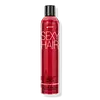TRESemmé Hairspray Freeze Hold Versus SexyHair Big Sexy Hair Spray & Play Harder Firm Volumizing Hairspray
What's inside
What's inside
 Concerns
Concerns

 Ingredients Side-by-side
Ingredients Side-by-side

Alcohol
AntimicrobialButane
Isobutane
Octylacrylamide/Acrylates/Butylaminoethyl Methacrylate Copolymer
Propane
Aminomethyl Propanol
BufferingParfum
MaskingWater
Skin ConditioningT-Butyl Alcohol
PerfumingPPG-12 Dimethicone
Skin ConditioningDenatonium Benzoate
MaskingAmyl Cinnamal
PerfumingBenzyl Alcohol
PerfumingCitronellol
PerfumingGeraniol
PerfumingHexyl Cinnamal
PerfumingHydroxycitronellal
PerfumingLimonene
PerfumingLinalool
PerfumingAlcohol, Butane, Isobutane, Octylacrylamide/Acrylates/Butylaminoethyl Methacrylate Copolymer, Propane, Aminomethyl Propanol, Parfum, Water, T-Butyl Alcohol, PPG-12 Dimethicone, Denatonium Benzoate, Amyl Cinnamal, Benzyl Alcohol, Citronellol, Geraniol, Hexyl Cinnamal, Hydroxycitronellal, Limonene, Linalool
Alcohol Denat.
AntimicrobialHydrofluorocarbon 152a
Octylacrylamide/Acrylates/Butylaminoethyl Methacrylate Copolymer
Water
Skin ConditioningAminomethyl Propanol
BufferingNeopentyl Glycol Diheptanoate
EmollientIsododecane
EmollientTriethyl Citrate
MaskingC12-15 Alkyl Benzoate
AntimicrobialParfum
MaskingPEG/PPG-17/18 Dimethicone
EmulsifyingPentaerythrityl Tetracaprylate/Tetracaprate
EmollientEthylhexyl Methoxycinnamate
UV AbsorberAmp-Isostearoyl Hydrolyzed Wheat Protein
CleansingBenzoic Acid
MaskingHexyl Cinnamal
PerfumingLimonene
PerfumingBenzyl Salicylate
PerfumingLinalool
PerfumingAlcohol Denat., Hydrofluorocarbon 152a, Octylacrylamide/Acrylates/Butylaminoethyl Methacrylate Copolymer, Water, Aminomethyl Propanol, Neopentyl Glycol Diheptanoate, Isododecane, Triethyl Citrate, C12-15 Alkyl Benzoate, Parfum, PEG/PPG-17/18 Dimethicone, Pentaerythrityl Tetracaprylate/Tetracaprate, Ethylhexyl Methoxycinnamate, Amp-Isostearoyl Hydrolyzed Wheat Protein, Benzoic Acid, Hexyl Cinnamal, Limonene, Benzyl Salicylate, Linalool
Ingredients Explained
These ingredients are found in both products.
Ingredients higher up in an ingredient list are typically present in a larger amount.
Aminomethyl Propanol is used to adjust the pH of products. It is also used as a base to create other organic compounds. Having a balanced pH is important for protecting your skin.
Aminomethyl propanol is safe to use in cosmetics up to 1%. It is soluble in water.
Hexyl Cinnamal is a fragrance ingredient with a similar scent to jasmine. It can be naturally found in chamomile essential oil.
This ingredient is a known EU allergen and may sensitize the skin. The EU requires this ingredient to be listed separately on an ingredients list.
Hexyl Cinnamal is not water soluble but is soluble in oils.
Learn more about Hexyl CinnamalLimonene is a fragrance that adds scent and taste to a formulation.
It's found in the peel oil of citrus fruits and other plants such as lavender and eucalyptus. The scent of limonene is generally described as "sweet citrus".
Limonene acts as an antioxidant, meaning it helps neutralize free radicals.
When exposed to air, oxidized limonene may sensitize the skin. Because of this, limonene is often avoided by people with sensitive skin.
The term 'fragrance' is not regulated in many countries. In many cases, it is up to the brand to define this term. For instance, many brands choose to label themselves as "fragrance-free" because they are not using synthetic fragrances. However, their products may still contain ingredients such as essential oils that are considered a fragrance.
Learn more about LimoneneLinalool is a fragrance and helps add scent to products. It's derived from common plants such as cinnamon, mint, citrus, and lavender.
Like Limonene, this ingredient oxidizes when exposed to air. Oxidized linalool can cause allergies and skin sensitivity.
This ingredient has a scent that is floral, spicy tropical, and citrus-like.
Learn more about LinaloolWe don't have a description for Octylacrylamide/Acrylates/Butylaminoethyl Methacrylate Copolymer yet.
Parfum is a catch-all term for an ingredient or more that is used to give a scent to products.
Also called "fragrance", this ingredient can be a blend of hundreds of chemicals or plant oils. This means every product with "fragrance" or "parfum" in the ingredients list is a different mixture.
For instance, Habanolide is a proprietary trade name for a specific aroma chemical. When used as a fragrance ingredient in cosmetics, most aroma chemicals fall under the broad labeling category of “FRAGRANCE” or “PARFUM” according to EU and US regulations.
The term 'parfum' or 'fragrance' is not regulated in many countries. In many cases, it is up to the brand to define this term.
For instance, many brands choose to label themselves as "fragrance-free" because they are not using synthetic fragrances. However, their products may still contain ingredients such as essential oils that are considered a fragrance by INCI standards.
One example is Calendula flower extract. Calendula is an essential oil that still imparts a scent or 'fragrance'.
Depending on the blend, the ingredients in the mixture can cause allergies and sensitivities on the skin. Some ingredients that are known EU allergens include linalool and citronellol.
Parfum can also be used to mask or cover an unpleasant scent.
The bottom line is: not all fragrances/parfum/ingredients are created equally. If you are worried about fragrances, we recommend taking a closer look at an ingredient. And of course, we always recommend speaking with a professional.
Learn more about ParfumWater. It's the most common cosmetic ingredient of all. You'll usually see it at the top of ingredient lists, meaning that it makes up the largest part of the product.
So why is it so popular? Water most often acts as a solvent - this means that it helps dissolve other ingredients into the formulation.
You'll also recognize water as that liquid we all need to stay alive. If you see this, drink a glass of water. Stay hydrated!
Learn more about Water